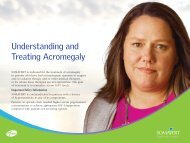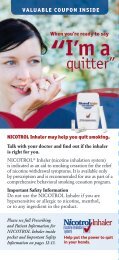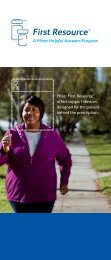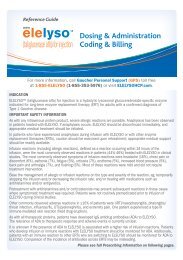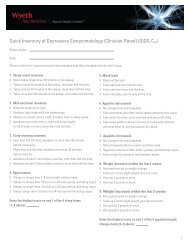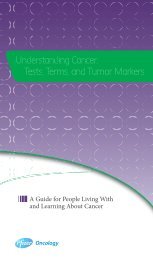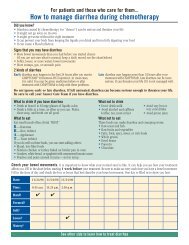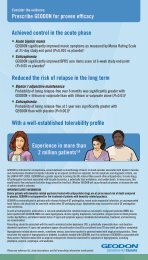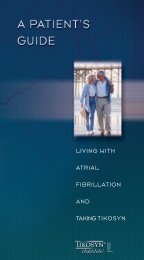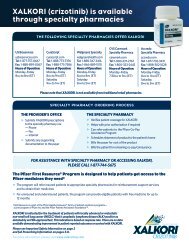TIKOSYN - ACC/AHA Guidelines for the Management of Patients With
TIKOSYN - ACC/AHA Guidelines for the Management of Patients With
TIKOSYN - ACC/AHA Guidelines for the Management of Patients With
Create successful ePaper yourself
Turn your PDF publications into a flip-book with our unique Google optimized e-Paper software.
<strong>TIKOSYN</strong> ® (d<strong>of</strong>etilide) Overview Slide Set1Indication<strong>TIKOSYN</strong> is indicated <strong>for</strong> <strong>the</strong> maintenance <strong>of</strong> normal sinus rhythm (delay in time to recurrence <strong>of</strong> atrial fibrillation/atrialflutter [AF/AFL]) in patients with atrial fibrillation/atrial flutter <strong>of</strong> greater than one week duration who have beenconverted to normal sinus rhythm. Because <strong>TIKOSYN</strong> can cause life-threatening ventricular arrhythmias, it should bereserved <strong>for</strong> patients in whom atrial fibrillation/atrial flutter is highly symptomatic. In general, antiarrhythmic <strong>the</strong>rapy <strong>for</strong>atrial fibrillation/atrial flutter aims to prolong <strong>the</strong> time in normal sinus rhythm. Recurrence is expected in some patients.<strong>TIKOSYN</strong> is indicated <strong>for</strong> <strong>the</strong> conversion <strong>of</strong> atrial fibrillation and atrial flutter to normal sinus rhythm.<strong>TIKOSYN</strong> has not been shown to be effective in patients with paroxysmal atrial fibrillation.Boxed WarningTo minimize <strong>the</strong> risk <strong>of</strong> induced arrhythmia, patients initiated on <strong>TIKOSYN</strong> should be placed <strong>for</strong> aminimum <strong>of</strong> 3 days in a facility that can provide calculations <strong>of</strong> creatinine clearance, continuouselectrocardiographic monitoring, and cardiac resuscitation. <strong>TIKOSYN</strong> is available only to hospitalsand prescribers who have received appropriate <strong>TIKOSYN</strong> dosing and treatment initiation education.Please see full Prescribing In<strong>for</strong>mation,including Boxed Warning, and MedicationGuide on slides 52-81, or visitwww.<strong>TIKOSYN</strong>HCP.com.
Introduction5•!Objectives•!Introduction•! AF•!Definition•!Prevalence•!Risk•!Classification•! AFL•! How <strong>TIKOSYN</strong> ® (d<strong>of</strong>etilide) can treat highly symptomatic AF/AFL•!<strong>TIKOSYN</strong> mechanism <strong>of</strong> action•!Pivotal efficacy data•!Safety/risks•!Pharmacokinetics•!Dosing and administration•!REMS•!Support resourcesBoxed WarningTo minimize <strong>the</strong> risk <strong>of</strong> induced arrhythmia, patients initiated on <strong>TIKOSYN</strong> should be placed <strong>for</strong> aminimum <strong>of</strong> 3 days in a facility that can provide calculations <strong>of</strong> creatinine clearance, continuouselectrocardiographic monitoring, and cardiac resuscitation. <strong>TIKOSYN</strong> is available only to hospitalsand prescribers who have received appropriate <strong>TIKOSYN</strong> dosing and treatment initiation education.Please see full Prescribing In<strong>for</strong>mation,including Boxed Warning, and MedicationGuide on slides 52-81, or visitwww.<strong>TIKOSYN</strong>HCP.com.
IntroductionThe <strong>ACC</strong>F/<strong>AHA</strong>/HRS recommends <strong>the</strong> following definitions <strong>for</strong> varioustypes <strong>of</strong> AF 1 :•! First-detected: First documented incident <strong>of</strong> AF; may be paroxysmal or persistent•! Recurrent: 2 or more episodes <strong>of</strong> AF in a single patient—! Paroxysmal: Self-terminating AF; converts spontaneously to normal sinus rhythm (NSR); usually asubtype <strong>of</strong> recurrent AF—! Persistent: AF that is sustained beyond 7 days and is capable <strong>of</strong> being converted to NSR; usually asubtype <strong>of</strong> recurrent AF•! Long-standing: AF lasting longer than 1 year•! Permanent: When a persistent AF becomes long-standing, it usually leads to a permanent AF, in whichcardioversion to NSR has failed or has not been attempted•! "Lone AF": Generally, applies to patients 440 msec (500 msec in patients with ventricular conduction abnormalities), severe renal impairment(calculated creatinine clearance
AF is a widely prevalent cardiac arrhythmia 1•! AF is a supraventricular tachyarrhythmia characterized by <strong>the</strong> presence <strong>of</strong> uncoordinatedatrial activation and deteriorating atrial mechanical function 1•! AF typically occurs in <strong>the</strong> presence <strong>of</strong> o<strong>the</strong>r cardiovascular diseaseor hypertension 1•! In 2008, it was estimated that AF affected 2.3 million people in <strong>the</strong> US 2—! By 2020, it is estimated that 3 million people will have AF 21. Fuster V, et al. Circulation. 2011;123(10):e269-e367.2. Kannel WB, Benjamin EJ. Med Clin North Am. 2008;92(1):17-ix.7Selected Safety In<strong>for</strong>mation<strong>TIKOSYN</strong> is also contraindicated with verapamil, hydrochlorothiazide (alone or in combination, such as withtriamterene), and cation transport system inhibitors such as cimetidine, ketoconazole, trimethoprim (alone or incombination with sulfamethoxazole), prochlorperazine, and megestrol because <strong>the</strong>se drugs may cause an increasein d<strong>of</strong>etilide plasma concentration.Please see full Prescribing In<strong>for</strong>mation,including Boxed Warning, and MedicationGuide on slides 52-81, or visitwww.<strong>TIKOSYN</strong>HCP.com.
AF is <strong>the</strong> most frequently encountered cardiacarrhythmia in practice 1Estimated overall prevalence in general population" 0.4% to 1.0%"Proportion <strong>of</strong> hospitalizations <strong>for</strong> cardiac arrhythmias due to AF " #33%"Incidence <strong>of</strong> chronic AF per year among patients >80 years <strong>of</strong> age"In men"In women""2.0%"1.5%"•! AF prevalence increases with each decade <strong>of</strong> life (up to 8% in patients aged >80 years) 18Selected Safety In<strong>for</strong>mation1. Fuster V, et al. Circulation. 2011;123(10):e269-e367.The most common adverse events reported were headache, chest pain, dizziness, respiratory tract infection,dyspnea, and nausea.Please see full Prescribing In<strong>for</strong>mation,including Boxed Warning, and MedicationGuide on slides 52-81, or visitwww.<strong>TIKOSYN</strong>HCP.com.
Persistent AF is associated with serious risks,such as 1 :•! Stroke—! The average rate <strong>of</strong> ischemic stroke among patients with nonvalvular AF is 2 to7 times higher than in patients without AF—! In patients with rheumatic heart disease, stroke risk is 17 times higher•! Congestive heart failure (CHF)•! Death—AF is associated with a 2-fold increase in <strong>the</strong> mortality rate linked to <strong>the</strong> severity<strong>of</strong> underlying heart disease•! O<strong>the</strong>r embolic events91. Fuster V, et al. Circulation. 2011;123(10):e269-e367.Selected Safety In<strong>for</strong>mation<strong>TIKOSYN</strong> is contraindicated in patients with congenital or acquired long QT syndromes, a baseline QT interval orQTc >440 msec (500 msec in patients with ventricular conduction abnormalities), severe renal impairment(calculated creatinine clearance
AF is commonly associated with AFL, ano<strong>the</strong>rtype <strong>of</strong> supraventricular tachyarrhythmia 1•! AFL may arise during treatment with antiarrhythmic agents prescribed to preventrecurrent AF•! AFL is characterized by a sawtooth pattern <strong>of</strong> regular atrial activation called flutter waveson <strong>the</strong> electrocardiogram (ECG)•! AFL may degenerate into AF, and AF may convert to AFL. The ECG pattern may fluctuatebetween AFL and AF, reflecting changing activation <strong>of</strong> <strong>the</strong> atria<strong>TIKOSYN</strong> ® (d<strong>of</strong>etilide) can help in <strong>the</strong> treatment <strong>of</strong> both highly symptomatic AF and AFL 2101. Fuster V, et al. Circulation. 2011;123(10):e269-e367.2. Tikosyn [prescribing in<strong>for</strong>mation]. New York, NY: Pfizer Inc; 2011.Boxed WarningTo minimize <strong>the</strong> risk <strong>of</strong> induced arrhythmia, patients initiated on <strong>TIKOSYN</strong> should be placed <strong>for</strong> aminimum <strong>of</strong> 3 days in a facility that can provide calculations <strong>of</strong> creatinine clearance, continuouselectrocardiographic monitoring, and cardiac resuscitation. <strong>TIKOSYN</strong> is available only to hospitalsand prescribers who have received appropriate <strong>TIKOSYN</strong> dosing and treatment initiation education.Please see full Prescribing In<strong>for</strong>mation,including Boxed Warning, and MedicationGuide on slides 52-81, or visitwww.<strong>TIKOSYN</strong>HCP.com.
<strong>TIKOSYN</strong> ® (d<strong>of</strong>etilide) is indicated <strong>for</strong> <strong>the</strong>maintenance <strong>of</strong> NSR* in highly symptomatic patientsas well as <strong>the</strong> conversion <strong>of</strong> AF/AFL to NSR 111•! <strong>TIKOSYN</strong> is indicated <strong>for</strong> <strong>the</strong> maintenance <strong>of</strong> normal sinus rhythm (delay intime to recurrence <strong>of</strong> atrial fibrillation/atrial flutter [AF/AFL]) in patients withatrial fibrillation/atrial flutter <strong>of</strong> greater than one week duration who have beenconverted to normal sinus rhythm•! Because <strong>TIKOSYN</strong> can cause life-threatening ventricular arrhythmias, itshould be reserved <strong>for</strong> patients in whom atrial fibrillation/atrial flutter ishighly symptomatic•! In general, antiarrhythmic <strong>the</strong>rapy <strong>for</strong> atrial fibrillation/atrial flutter aimsto prolong <strong>the</strong> time in normal sinus rhythm. Recurrence is expected insome patients•! <strong>TIKOSYN</strong> is indicated <strong>for</strong> <strong>the</strong> conversion <strong>of</strong> atrial fibrillation and atrial flutterto normal sinus rhythm•! <strong>TIKOSYN</strong> has not been shown to be effective in patients with paroxysmalatrial fibrillation*Delay in AF/AFL recurrence.1. Tikosyn [prescribing in<strong>for</strong>mation]. New York, NY: Pfizer Inc; 2011.Boxed WarningTo minimize <strong>the</strong> risk <strong>of</strong> induced arrhythmia, patients initiated on <strong>TIKOSYN</strong> should be placed <strong>for</strong> aminimum <strong>of</strong> 3 days in a facility that can provide calculations <strong>of</strong> creatinine clearance, continuouselectrocardiographic monitoring, and cardiac resuscitation. <strong>TIKOSYN</strong> is available only to hospitalsand prescribers who have received appropriate <strong>TIKOSYN</strong> dosing and treatment initiation education.Please see full Prescribing In<strong>for</strong>mation,including Boxed Warning, and MedicationGuide on slides 52-81, or visitwww.<strong>TIKOSYN</strong>HCP.com.
<strong>TIKOSYN</strong> ® (d<strong>of</strong>etilide) is recommended as afirst-line <strong>the</strong>rapy option in AF treatment <strong>for</strong> somepatient types 1Selected SafetyIn<strong>for</strong>mationThe most commonadverse eventsreported wereheadache, chest pain,dizziness, respiratorytract infection,dyspnea, and nausea.•! Among highly symptomatic AF patients with coronary artery disease orheart failure, <strong>the</strong> 2011 <strong>ACC</strong>F/<strong>AHA</strong>/HRS treatment guidelines recommend<strong>TIKOSYN</strong> as a first-line treatment option<strong>With</strong>in each box, drugs are listed alphabetically and not in order <strong>of</strong> suggested use. The vertical flow indicates order <strong>of</strong>preference under each condition. The seriousness <strong>of</strong> heart disease proceeds from left to right, and selection <strong>of</strong> <strong>the</strong>rapy inpatients with multiple conditions depends on <strong>the</strong> most serious condition present. LVH indicates left ventricular hypertrophy.Please see full Prescribing In<strong>for</strong>mation,including Boxed Warning, and MedicationGuide on slides 52-81, or visitwww.<strong>TIKOSYN</strong>HCP.com.121. Fuster V, et al. Circulation. 2011;123(10):e269-e367.
<strong>TIKOSYN</strong> ® (d<strong>of</strong>etilide) mechanism <strong>of</strong> action•!Objectives•!Introduction•!<strong>TIKOSYN</strong> mechanism <strong>of</strong> action—! How <strong>the</strong> mechanism <strong>of</strong> action <strong>of</strong> <strong>TIKOSYN</strong> facilitates <strong>the</strong> conversion and maintenance <strong>of</strong> NSR byaffecting <strong>the</strong>:•! Action potential•! QT interval•!Pivotal efficacy data•!Safety/risks•!Pharmacokinetics•!Dosing and administration•!REMS•!Support resources13Boxed WarningTo minimize <strong>the</strong> risk <strong>of</strong> induced arrhythmia, patients initiated on <strong>TIKOSYN</strong> should be placed <strong>for</strong> aminimum <strong>of</strong> 3 days in a facility that can provide calculations <strong>of</strong> creatinine clearance, continuouselectrocardiographic monitoring, and cardiac resuscitation. <strong>TIKOSYN</strong> is available only to hospitalsand prescribers who have received appropriate <strong>TIKOSYN</strong> dosing and treatment initiation education.Please see full Prescribing In<strong>for</strong>mation,including Boxed Warning, and MedicationGuide on slides 52-81, or visitwww.<strong>TIKOSYN</strong>HCP.com.
The selective potassium channel-blocking activity<strong>of</strong> <strong>TIKOSYN</strong> ® (d<strong>of</strong>etilide) increases <strong>the</strong>monophasic action potential duration 114•! <strong>TIKOSYN</strong> blocks only I Kr with no relevant block <strong>of</strong> <strong>the</strong> o<strong>the</strong>r repolarizing potassiumcurrents (eg, I Ks , I K1 )—! Blockage <strong>of</strong> I Kr is associated with Vaughan Williams Class III antiarrhythmic activity•! At clinically relevant concentrations, <strong>TIKOSYN</strong> has no effect onsodium channels, adrenergic alpha-receptors,or adrenergic beta-receptors1. Tikosyn [prescribing in<strong>for</strong>mation]. New York, NY: Pfizer Inc; 2011.Boxed WarningTo minimize <strong>the</strong> risk <strong>of</strong> induced arrhythmia, patients initiated on <strong>TIKOSYN</strong> should be placed <strong>for</strong> aminimum <strong>of</strong> 3 days in a facility that can provide calculations <strong>of</strong> creatinine clearance, continuouselectrocardiographic monitoring, and cardiac resuscitation. <strong>TIKOSYN</strong> is available only to hospitalsand prescribers who have received appropriate <strong>TIKOSYN</strong> dosing and treatment initiation education.Please see full Prescribing In<strong>for</strong>mation,including Boxed Warning, and MedicationGuide on slides 52-81, or visitwww.<strong>TIKOSYN</strong>HCP.com.
In electrophysiology studies, <strong>TIKOSYN</strong> ® (d<strong>of</strong>etilide)was found to stop conditions such as AF/AFL andprevent <strong>the</strong>ir recurrence 1By increasing action potential duration, <strong>TIKOSYN</strong> 1 :•! Increases <strong>the</strong> QT interval observed on <strong>the</strong> surface ECG•! Terminates induced reentrant tachyarrhythmias such as AF andAFL and prevents <strong>the</strong>ir reinduction151. Tikosyn [prescribing in<strong>for</strong>mation]. New York, NY: Pfizer Inc; 2011.Boxed WarningTo minimize <strong>the</strong> risk <strong>of</strong> induced arrhythmia, patients initiated on <strong>TIKOSYN</strong> should be placed <strong>for</strong> aminimum <strong>of</strong> 3 days in a facility that can provide calculations <strong>of</strong> creatinine clearance, continuouselectrocardiographic monitoring, and cardiac resuscitation. <strong>TIKOSYN</strong> is available only to hospitalsand prescribers who have received appropriate <strong>TIKOSYN</strong> dosing and treatment initiation education.Please see full Prescribing In<strong>for</strong>mation,including Boxed Warning, and MedicationGuide on slides 52-81, or visitwww.<strong>TIKOSYN</strong>HCP.com.
Pivotal efficacy data!!•!Objectives•!Introduction•!<strong>TIKOSYN</strong> ® (d<strong>of</strong>etilide) mechanism <strong>of</strong> action•!Pivotal efficacy data—! EMERALD: European and Australian Multicenter Evaluative Research on Atrial FibrillationD<strong>of</strong>etilide—! SAFIRE-D: Symptomatic Atrial Fibrillation Investigative Research on D<strong>of</strong>etilide•!Safety/risks•!Pharmacokinetics•!Dosing and administration•!REMS•!Support resources16Boxed WarningTo minimize <strong>the</strong> risk <strong>of</strong> induced arrhythmia, patients initiated on <strong>TIKOSYN</strong> should be placed <strong>for</strong> aminimum <strong>of</strong> 3 days in a facility that can provide calculations <strong>of</strong> creatinine clearance, continuouselectrocardiographic monitoring, and cardiac resuscitation. <strong>TIKOSYN</strong> is available only to hospitalsand prescribers who have received appropriate <strong>TIKOSYN</strong> dosing and treatment initiation education.Please see full Prescribing In<strong>for</strong>mation,including Boxed Warning, and MedicationGuide on slides 52-81, or visitwww.<strong>TIKOSYN</strong>HCP.com.
EMERALD: European and Australian MulticenterEvaluative Research on Atrial Fibrillation D<strong>of</strong>etilideStudy design•! A large-scale, placebo-controlled, randomized, 12-month study <strong>of</strong> 671 patients with aprimary diagnosis <strong>of</strong> AF/AFL <strong>of</strong> between 1 week and 2 years duration 1•! <strong>Patients</strong> were randomized to 1 <strong>of</strong> 5 treatment groups 1 :—! 500 mcg <strong>TIKOSYN</strong> ® (d<strong>of</strong>etilide) BID—! 250 mcg <strong>TIKOSYN</strong> BID—! 125 mcg <strong>TIKOSYN</strong> BID—! 80 mg sotalol BID—! Placebo•! Dosage was based on calculated creatinine clearance (CrCl) 2•! ECG was monitored <strong>for</strong> <strong>the</strong> first 3 days <strong>of</strong> treatment 2•! Primary end points 1, 2 :—! Conversion phase: Time to and rate <strong>of</strong> conversion<strong>of</strong> AF/AFL to NSR—! Maintenance phase: Times to first relapse to AF/AFLPlease see full Prescribing In<strong>for</strong>mation,including Boxed Warning, and MedicationGuide on slides 52-81, or visitwww.<strong>TIKOSYN</strong>HCP.com.171. Data on file. Pfizer Inc, New York, NY.2. Tikosyn [prescribing in<strong>for</strong>mation]. New York, NY: Pfizer Inc; 2011.
SAFIRE-D: Symptomatic Atrial FibrillationInvestigative Research on D<strong>of</strong>etilideStudy design 1,2•! A placebo-controlled, randomized,12-month study <strong>of</strong> 325 patients with a primarydiagnosis <strong>of</strong> AF/AFL <strong>of</strong> more than 1 week duration 1,2•! Most patients had New York Heart Association (NYHA) Class II or III structural heartdisease (SHD)•! <strong>Patients</strong> were randomized to 1 <strong>of</strong> 4 treatment groups:—! 500 mcg <strong>TIKOSYN</strong> ® (d<strong>of</strong>etilide) BID—! 250 mcg <strong>TIKOSYN</strong> BID—! 125 mcg <strong>TIKOSYN</strong> BID—! Placebo•! Dosage was:—! Based on calculated creatinine clearance—! Adjusted downward after evaluation <strong>of</strong> QT response to <strong>the</strong>rapy•! ECG was monitored <strong>for</strong> <strong>the</strong> first 3 days <strong>of</strong> treatment, at a minimum•! Primary end points:—! Conversion phase: Time to and rate <strong>of</strong> conversion<strong>of</strong> AF/AFL to NSR—! Maintenance phase: Times to first relapse to AF/AFLPlease see full Prescribing In<strong>for</strong>mation,including Boxed Warning, and MedicationGuide on slides 52-81, or visitwww.<strong>TIKOSYN</strong>HCP.com.181. Tikosyn [prescribing in<strong>for</strong>mation]. New York, NY: Pfizer Inc; 2011.2. Singh S, et al. Circulation. 2000;102(19):2385-2390.
The majority <strong>of</strong> patients in EMERALD and SAFIRE-Dhad a primary diagnosis <strong>of</strong> AF 1Baseline characteristics <strong>of</strong> patients in EMERALD and SAFIRE-DEMERALD(N=671)SAFIRE-D(N=325)Male 471 (70.2%) 273 (84.0%)Age (mean years) 64 67Weight (mean kg) 81 88RaceWhiteBlackAsianO<strong>the</strong>r669 (99.7%)0 (0.0%)1 (
Pharmacological conversion increases withincreasing doses <strong>of</strong> <strong>TIKOSYN</strong> ® (d<strong>of</strong>etilide) 135EMERALDSAFIRE-D30Converted to NSR (%)2520151056.0*6.129.5 † 29.9 §10.5 † 9.8 ‡ 1.5 1.20(n=135) (n=82)<strong>TIKOSYN</strong> 125 mcgBID(n=133) (n=82)<strong>TIKOSYN</strong> 250 mcgBID(n=129) (n=77)<strong>TIKOSYN</strong> 500 mcgBID(n=137) (n=84)Placebo•! 70% <strong>of</strong> <strong>the</strong> patients who converted pharmacologically achieved NSR within 24 to 36 hours <strong>of</strong> initiation <strong>of</strong> <strong>the</strong>rapy 1*P=.037 vs placebo; † P=.001 vs placebo; ‡ P=.015 vs placebo; § P
<strong>Patients</strong> receiving <strong>TIKOSYN</strong> ® (d<strong>of</strong>etilide) weremore likely to remain in NSR at 12 months 1,2EMERALD: PROBABILITY OF REMAINING IN NSR AFTERCONVERSION TO NSR WITH <strong>TIKOSYN</strong> OR PLACEBOSAFIRE-D: PROBABILITY OF REMAINING IN NSR AFTERCONVERSION TO NSR WITH <strong>TIKOSYN</strong> OR PLACEBO211. Data on file. Pfizer Inc, New York, NY.2. Singh S, et al. Circulation. 2000;102(19):2385-2390.Boxed WarningTo minimize <strong>the</strong> risk <strong>of</strong> induced arrhythmia, patients initiated on <strong>TIKOSYN</strong> should be placed <strong>for</strong> aminimum <strong>of</strong> 3 days in a facility that can provide calculations <strong>of</strong> creatinine clearance, continuouselectrocardiographic monitoring, and cardiac resuscitation. <strong>TIKOSYN</strong> is available only to hospitalsand prescribers who have received appropriate <strong>TIKOSYN</strong> dosing and treatment initiation education.Please see full Prescribing In<strong>for</strong>mation,including Boxed Warning, and MedicationGuide on slides 52-81, or visitwww.<strong>TIKOSYN</strong>HCP.com.
<strong>TIKOSYN</strong> ® (d<strong>of</strong>etilide) patients were significantlymore likely to stay in NSR at 12 months 1Probability <strong>of</strong> remaining in NSRDose Study n 6 months 12 monthsP value vs placebo(at 12 months)<strong>TIKOSYN</strong>500 mcg BIDEMERALDSAFIRE-D1006171%62%66%58%.0001.001<strong>TIKOSYN</strong>250 mcg BIDEMERALDSAFIRE-D1186156%50%52%37%.0001.104<strong>TIKOSYN</strong>125 mcg BIDEMERALDSAFIRE-D1036051%44%40%40%.0048.208PlaceboEMERALDSAFIRE-D1066826%37%21%25%N/AN/A22•! <strong>Patients</strong> still on treatment and in NSR with <strong>TIKOSYN</strong> 500 mcg 2 :—! At 6 months: 57% (EMERALD); 52% (SAFIRE-D)—! At 12 months: 49% (EMERALD); 46% (SAFIRE-D)1. Data on file. Pfizer Inc, New York, NY.2. Tikosyn [prescribing in<strong>for</strong>mation]. New York, NY: Pfizer Inc; 2011.Boxed WarningTo minimize <strong>the</strong> risk <strong>of</strong> induced arrhythmia, patients initiated on <strong>TIKOSYN</strong> should be placed <strong>for</strong> aminimum <strong>of</strong> 3 days in a facility that can provide calculations <strong>of</strong> creatinine clearance, continuouselectrocardiographic monitoring, and cardiac resuscitation. <strong>TIKOSYN</strong> is available only to hospitalsand prescribers who have received appropriate <strong>TIKOSYN</strong> dosing and treatment initiation education.Please see full Prescribing In<strong>for</strong>mation,including Boxed Warning, and MedicationGuide on slides 52-81, or visitwww.<strong>TIKOSYN</strong>HCP.com.
Safety/risks•! Objectives•! Introduction•! <strong>TIKOSYN</strong> ® (d<strong>of</strong>etilide) mechanism <strong>of</strong> action•! Pivotal efficacy data•! Safety/risks—! Clinical safety experience with <strong>TIKOSYN</strong> as demonstrated in large, randomized, multicenterclinical trials•! DIAMOND-CHF and DIAMOND-MI•! DIAMOND-AF—! Torsade de Pointes (TdP) and o<strong>the</strong>r ventricular arrhythmias associated with <strong>TIKOSYN</strong>—! The most common adverse reactions associated with <strong>TIKOSYN</strong>—! <strong>TIKOSYN</strong> tolerability—! <strong>TIKOSYN</strong> contraindications—! Drugs that interact with <strong>TIKOSYN</strong>—! Warnings and precautions associated with <strong>TIKOSYN</strong>•! Pharmacokinetics•! Dosing and administration•! REMS•! Support resourcesSelected Safety In<strong>for</strong>mation<strong>TIKOSYN</strong> is also contraindicated with verapamil, hydrochlorothiazide (alone or in combination, such as withtriamterene), and cation transport system inhibitors such as cimetidine, ketoconazole, trimethoprim (alone or incombination with sulfamethoxazole), prochlorperazine, and megestrol because <strong>the</strong>se drugs may cause an increase23 in d<strong>of</strong>etilide plasma concentration.Please see full Prescribing In<strong>for</strong>mation,including Boxed Warning, and MedicationGuide on slides 52-81, or visitwww.<strong>TIKOSYN</strong>HCP.com.
DIAMOND-CHF and DIAMOND-MI evaluated <strong>the</strong> effect<strong>of</strong> <strong>TIKOSYN</strong> ® (d<strong>of</strong>etilide) on morbidity and mortality inpatients with impaired left ventricular function 1Danish Investigations <strong>of</strong> Arrhythmia and Mortality on D<strong>of</strong>etilide (DIAMOND)•! Study design—! 2 separate multicenter, randomized, double-blind, placebo-controlled, parallel-group,3-year studies on mortality and morbidity 1,2—! DIAMOND-CHF: 1518 patients with moderate to severe congestive heart failure(60% NYHA Class III or IV) 2—! DIAMOND-MI: 1510 patients with a recent myocardial infarction (MI) (40% NYHAClass III or IV) 2—! End points included all-cause mortality and hospitalization due to worsening CHF 1,3,41. The DIAMOND Study Group. Clin Cardiol. 1997;20(8):704-710."2. Tikosyn [prescribing in<strong>for</strong>mation]. New York, NY: Pfizer Inc; 2011."3. Kober L, et al. Lancet. 2000;356(9247):2052-2058."4. Torp-Pederson C, et al. N Engl J Med. 1999;341(12):857-865."Selected Safety In<strong>for</strong>mation<strong>TIKOSYN</strong> can cause serious ventricular arrhythmias, primarily Torsade de Pointes type ventricular tachycardia,a polymorphic ventricular tachycardia associated with QT interval prolongation. QT interval prolongation is directlyrelated to d<strong>of</strong>etilide plasma concentrations. Factors such as reduced creatinine clearance or certain d<strong>of</strong>etilide druginteractions will increase d<strong>of</strong>etilide plasma concentration. The risk <strong>of</strong> TdP can be reduced by controlling <strong>the</strong>plasma concentration through adjustment <strong>of</strong> <strong>the</strong> initial d<strong>of</strong>etilide dose according to creatinine clearance and bymonitoring <strong>the</strong> ECG <strong>for</strong> excessive increases in <strong>the</strong> QT interval. Calculation <strong>of</strong> creatinine clearance and QTc <strong>for</strong>all patients must precede administration <strong>of</strong> <strong>the</strong> first dose <strong>of</strong> <strong>TIKOSYN</strong>. Renal function and QTc should be24 re-evaluated every 3 months or as medically warranted.Please see full Prescribing In<strong>for</strong>mation,including Boxed Warning, and MedicationGuide on slides 52-81, or visitwww.<strong>TIKOSYN</strong>HCP.com.
DIAMOND-CHF and DIAMOND-MI evaluated <strong>the</strong> effect<strong>of</strong> <strong>TIKOSYN</strong> ® (d<strong>of</strong>etilide) on morbidity and mortality inpatients with impaired left ventricular function 1!DIAMOND•! Study design (cont’d)—! <strong>Patients</strong> received medication as follows:•! <strong>Patients</strong> in NSR: 500 mcg <strong>TIKOSYN</strong> BID or placebo•! <strong>Patients</strong> with reduced CrCI or AF/AFL: 250 mcg <strong>TIKOSYN</strong> BID or QD or placebo—! Dosage was:•! Based on calculated creatinine clearance•! Adjusted downward after evaluation <strong>of</strong> QT response to <strong>the</strong>rapy•! Discontinued if dose reduction was required at lowest possible dose study—! ECG was monitored <strong>for</strong> <strong>the</strong> first 3 days <strong>of</strong> treatment25Selected Safety In<strong>for</strong>mation1. The DIAMOND Study Group. Clin Cardiol. 1997;20(8):704-710.The most common adverse events reported were headache, chest pain, dizziness, respiratory tract infection, dyspnea,and nausea.Please see full Prescribing In<strong>for</strong>mation,including Boxed Warning, and MedicationGuide on slides 52-81, or visitwww.<strong>TIKOSYN</strong>HCP.com.
DIAMOND-CHF and DIAMOND-MI 1Patient demographics<strong>TIKOSYN</strong>(n=762)DIAMOND-CHF 1 DIAMOND-MI 2PLACEBO(n=756)<strong>TIKOSYN</strong>(n=749)PLACEBO(n=761)Male 72% 75% 72% 75%Age (mean years) 70 70 68 69NYHA Class II 35% 39% 54% 53%NYHA Class III 56% 51% 30% 32%NYHA Class IV 6% 7% 5% 4%History <strong>of</strong> MI 51% 52% 36%* 37%*Beta blockers 9% 11% 36% 37%ACE inhibitors 72% 76% 59% 57%*These percentages refer to those patients with a history <strong>of</strong> MI be<strong>for</strong>e <strong>the</strong>ir recent MI. Allpatients in DIAMOND-MI had a recent MI (within 7 days prior to enrollment).Please see full Prescribing In<strong>for</strong>mation,including Boxed Warning, and MedicationGuide on slides 52-81, or visitwww.<strong>TIKOSYN</strong>HCP.com.261. Torp-Pederson C, et al. N Engl J Med. 1999;341(12):857-865.2. Kober L, et al. Lancet. 2000;356(9247):2052-2058.
<strong>TIKOSYN</strong> ® (d<strong>of</strong>etilide) had no significant effecton all-cause mortality in DIAMOND-CHFand DIAMOND-MI 1,2ESTIMATE OF THE PROBABILITYOF SURVIVAL IN DIAMOND-CHF 1ESTIMATE OF THE PROBABILITYOF SURVIVAL IN DIAMOND-MI 227•! The probability <strong>of</strong> survival at 1 year with <strong>TIKOSYN</strong> was 3 :—! DIAMOND-CHF: 73% (95% CI: 70%-76%)—! DIAMOND-MI: 79% (95% CI: 76%-82%)1. Torp-Pederson C, et al. N Engl J Med. 1999;341(12):857-865.2. Kober L, et al. Lancet. 2000;356(9247):2052-2058.3. Tikosyn [prescribing in<strong>for</strong>mation]. New York, NY: Pfizer Inc; 2011.Boxed WarningTo minimize <strong>the</strong> risk <strong>of</strong> induced arrhythmia, patients initiated on <strong>TIKOSYN</strong> should be placed <strong>for</strong> aminimum <strong>of</strong> 3 days in a facility that can provide calculations <strong>of</strong> creatinine clearance, continuouselectrocardiographic monitoring, and cardiac resuscitation. <strong>TIKOSYN</strong> is available only to hospitalsand prescribers who have received appropriate <strong>TIKOSYN</strong> dosing and treatment initiation education.Please see full Prescribing In<strong>for</strong>mation,including Boxed Warning, and MedicationGuide on slides 52-81, or visitwww.<strong>TIKOSYN</strong>HCP.com.
DIAMOND-AF studied <strong>the</strong> safety <strong>of</strong> <strong>TIKOSYN</strong> ®(d<strong>of</strong>etilide) in patients with AF 1!•! Subpopulation <strong>of</strong> 506 patients in <strong>the</strong> 2 DIAMOND studies who had AF at entry to <strong>the</strong>studies•! Study design—! <strong>Patients</strong> were randomized to 1 <strong>of</strong> 2 treatment groups•! 250 mcg BID (n=249)•! Placebo (n=257)—! End points included mortality and time to all-cause hospitalization, and hospitalization <strong>for</strong>worsening CHF 21. Tikosyn [prescribing in<strong>for</strong>mation]. New York, NY: Pfizer Inc; 2011."2. The DIAMOND Study Group. Clin Cardiol. 1997;20(8):704-710."Selected Safety In<strong>for</strong>mation<strong>TIKOSYN</strong> is contraindicated in patients with congenital or acquired long QT syndromes, a baseline QT interval orQTc >440 msec (500 msec in patients with ventricular conduction abnormalities), severe renal impairment28 (calculated creatinine clearance
DIAMOND-AF: <strong>TIKOSYN</strong> ® (d<strong>of</strong>etilide) improved conversionand maintenance <strong>of</strong> NSR and showed similar rates <strong>of</strong> overallsurvival and hospitalization <strong>for</strong> worsening CHF with placebo 1Percentage <strong>of</strong> patients90%80%70%60%50%40%30%20%10%0%CONVERSION AND MAINTENANCE OF NSR IN DIAMOND-AF12%2%Converted to NSR at 1 month•! Hospital readmission rates <strong>for</strong> any reason were 125/249 or 50% on <strong>TIKOSYN</strong> and 156/257 or 61%on placebo. Of <strong>the</strong>se, readmission rates <strong>for</strong> worsening heart failure were 73/249 or 29% on <strong>TIKOSYN</strong>and 102/257 or 40% <strong>for</strong> placebo 179%42%Remaining in NSR at 1 year<strong>TIKOSYN</strong>Placebo291. Tikosyn [prescribing in<strong>for</strong>mation]. New York, NY: Pfizer Inc; 2011."Boxed WarningTo minimize <strong>the</strong> risk <strong>of</strong> induced arrhythmia, patients initiated on <strong>TIKOSYN</strong> should be placed <strong>for</strong> aminimum <strong>of</strong> 3 days in a facility that can provide calculations <strong>of</strong> creatinine clearance, continuouselectrocardiographic monitoring, and cardiac resuscitation. <strong>TIKOSYN</strong> is available only to hospitalsand prescribers who have received appropriate <strong>TIKOSYN</strong> dosing and treatment initiation education.Please see full Prescribing In<strong>for</strong>mation,including Boxed Warning, and MedicationGuide on slides 52-81, or visitwww.<strong>TIKOSYN</strong>HCP.com.
In <strong>the</strong> DIAMOND trials, <strong>the</strong> incidence <strong>of</strong>TdP showed a dose-dependent relationship to<strong>TIKOSYN</strong> ® (d<strong>of</strong>etilide) 1•!Like o<strong>the</strong>r Vaughan Williams Class III antiarrhythmic drugs, <strong>TIKOSYN</strong> may causeventricular arrhythmias, including TdP—! TdP occurrence increased with <strong>TIKOSYN</strong> dose—! QT interval prolongation is directly related to d<strong>of</strong>etilide plasma concentration—! Incidence <strong>of</strong> TdP decreased after initiation <strong>of</strong> <strong>the</strong> <strong>TIKOSYN</strong> dosing regimen basedon renal function1. Tikosyn [prescribing in<strong>for</strong>mation]. New York, NY: Pfizer Inc; 2011.Selected Safety In<strong>for</strong>mation<strong>TIKOSYN</strong> is contraindicated in patients with congenital or acquired long QT syndromes, a baseline QT intervalor QTc >440 msec (500 msec in patients with ventricular conduction abnormalities), severe renal impairment30 (calculated creatinine clearance
The introduction <strong>of</strong> <strong>the</strong> <strong>TIKOSYN</strong> ® (d<strong>of</strong>etilide)dosing regimen resulted in a reduction in <strong>the</strong>incidence <strong>of</strong> TdP 1TOTAL BEFORE AFTERPopulation n/N (%) n/N (%) n/N (%)Supraventriculararrhythmias (SVAs)11/1346 (0.8%) 6/193 (3.1%) 5/1153 (0.4%)DIAMOND-CHF 25/762 (3.3%) 7/148 (4.7%) 18/614 (2.9%)DIAMOND-MI 7/749 (0.9%) 3/101 (3.0%) 4/648 (0.6%)DIAMOND-AF 4/249 (1.6%) 0/43 (0.0%) 4/206 (1.9%)•!Compliance with <strong>the</strong> <strong>TIKOSYN</strong> dosing algorithm has been shown to reduce<strong>the</strong> risk <strong>of</strong> TdP311. Tikosyn [prescribing in<strong>for</strong>mation]. New York, NY: Pfizer Inc; 2011.Boxed WarningTo minimize <strong>the</strong> risk <strong>of</strong> induced arrhythmia, patients initiated on <strong>TIKOSYN</strong> should be placed <strong>for</strong> aminimum <strong>of</strong> 3 days in a facility that can provide calculations <strong>of</strong> creatinine clearance, continuouselectrocardiographic monitoring, and cardiac resuscitation. <strong>TIKOSYN</strong> is available only to hospitalsand prescribers who have received appropriate <strong>TIKOSYN</strong> dosing and treatment initiation education.Please see full Prescribing In<strong>for</strong>mation,including Boxed Warning, and MedicationGuide on slides 52-81, or visitwww.<strong>TIKOSYN</strong>HCP.com.
Lower doses <strong>of</strong> <strong>TIKOSYN</strong> ® (d<strong>of</strong>etilide) areassociated with lower rates <strong>of</strong> dangerousventricular arrhythmias 1<strong>TIKOSYN</strong> DOSAGEPLACEBOArrhythmia event250-500 mcgBID(n=703)>500 mcgBID(n=38)(n=677)Ventricular arrhythmias* † 3.7% 2.6% 3.4% 15.8% 2.7%Ventricular fibrillation 0.0% 0.3% 0.4% 2.6% 0.1%Ventricular tachycardia † 3.7% 2.6% 3.3% 13.2% 2.5%TdP 0.0% 0.3% 0.9% 10.5% 0.0%•! TdP is <strong>the</strong> most serious side effect associated with <strong>TIKOSYN</strong>, yetis dose-dependent32*<strong>Patients</strong> with more than one arrhythmia are counted only once in this category.†Ventricular arrhythmias and ventricular tachycardia include all cases <strong>of</strong> TdP.1. Tikosyn [prescribing in<strong>for</strong>mation]. New York, NY: Pfizer Inc; 2011.Boxed WarningTo minimize <strong>the</strong> risk <strong>of</strong> induced arrhythmia, patients initiated on <strong>TIKOSYN</strong> should be placed <strong>for</strong> aminimum <strong>of</strong> 3 days in a facility that can provide calculations <strong>of</strong> creatinine clearance, continuouselectrocardiographic monitoring, and cardiac resuscitation. <strong>TIKOSYN</strong> is available only to hospitalsand prescribers who have received appropriate <strong>TIKOSYN</strong> dosing and treatment initiation education.Please see full Prescribing In<strong>for</strong>mation,including Boxed Warning, and MedicationGuide on slides 52-81, or visitwww.<strong>TIKOSYN</strong>HCP.com.
The most frequent adverse events associatedwith <strong>TIKOSYN</strong> ® (d<strong>of</strong>etilide) included headache, chestpain, and dizziness 1Adverse events occurring at >2% with <strong>TIKOSYN</strong> in patients with SVAs<strong>TIKOSYN</strong> PLACEBOAdverse Event % %Headache 11 9Chest pain 10 7Dizziness 8 6Respiratory tract infection 7 5Dyspnea 6 5Nausea 5 4Flu syndrome 4 2Selected Safety In<strong>for</strong>mation<strong>TIKOSYN</strong> is also contraindicated withverapamil, hydrochlorothiazide (alone or incombination, such as with triamterene),and cation transport system inhibitors suchas cimetidine, ketoconazole, trimethoprim(alone or in combination withsulfamethoxazole), prochlorperazine, andmegestrol because <strong>the</strong>se drugs maycause an increase in d<strong>of</strong>etilideplasma concentration.Insomnia 4 3Accidental injury 3 1Back pain 3 2Procedure (medical/surgery/health service) 3 2Diarrhea 3 2Rash 3 2Abdominal pain 3 2Please see full Prescribing In<strong>for</strong>mation,including Boxed Warning, and MedicationGuide on slides 52-81, or visitwww.<strong>TIKOSYN</strong>HCP.com.331. Tikosyn [prescribing in<strong>for</strong>mation]. New York, NY: Pfizer Inc; 2011.
<strong>TIKOSYN</strong> ® (d<strong>of</strong>etilide) was well-tolerated and wasnot discontinued significantly more <strong>of</strong>tenthan placebo 1Discontinuation rates due to adverse reactions in studies <strong>of</strong>patients with SVAs in <strong>the</strong> <strong>TIKOSYN</strong> clinical program 1<strong>Patients</strong> discontinuing <strong>TIKOSYN</strong>(%)10.0%8.0%6.0%4.0%2.0%0.0%8.7%<strong>TIKOSYN</strong> (n=1346)•! The most frequent reason <strong>for</strong> discontinuation (>1%)was ventricular tachycardia (2.0% on <strong>TIKOSYN</strong>vs 1.3% on placebo) 18.0%Placebo (n=677)Please see full Prescribing In<strong>for</strong>mation,including Boxed Warning, and MedicationGuide on slides 52-81, or visitwww.<strong>TIKOSYN</strong>HCP.com.341. Tikosyn [prescribing in<strong>for</strong>mation]. New York, NY: Pfizer Inc; 2011.
<strong>TIKOSYN</strong> ® (d<strong>of</strong>etilide) use should be avoided inpatients who are contraindicated 1•!<strong>TIKOSYN</strong> is contraindicated in patients with congenital or acquired longQT syndromes—! <strong>TIKOSYN</strong> should not be used in patients with a baseline QT interval or QTc >440 msec(500 msec in patients with ventricular conduction abnormalities)•!<strong>TIKOSYN</strong> is also contraindicated in patients with severe renal impairment (calculated creatinineclearance
Careful attention should be paid to <strong>the</strong>interactions <strong>of</strong> <strong>TIKOSYN</strong> ® (d<strong>of</strong>etilide) in order toensure its safe use 1<strong>TIKOSYN</strong> should not betaken with:•! Verapamil•! Hydrochlorothiazide (aloneor in combinations such as withtriamterene)•! Cimetidine•! Ketoconazole•! Trimethoprim (alone or incombination withsulfamethoxazole)•! Prochlorperazine•! MegestrolThe use <strong>of</strong> <strong>TIKOSYN</strong> with drugs thatprolong <strong>the</strong> QT interval has not beenstudied and is not recommended:•! Phenothiazines•! Cisapride•! Bepridil•! Tricyclic antidepressants•! Certain oral macrolides•! Certain fluoroquinolones<strong>TIKOSYN</strong> should be cautiously coadministeredwithCYP3A4 isoenzyme inhibitors:•! Macrolide antibiotics•! Azole antifungal agents•! Protease inhibitors•! Serotonin reuptake inhibitors•! Amiodarone•! Cannabinoids•! Dilitiazem•! Grapefruit juice•! Nefazodone•! Norfloxacin•! Quinine•! Zafirlukast<strong>TIKOSYN</strong> does not inhibit <strong>the</strong> CYP34A orcytochrome P450 isoenzymesPlease see full Prescribing In<strong>for</strong>mation,including Boxed Warning, and MedicationGuide on slides 52-81, or visitwww.<strong>TIKOSYN</strong>HCP.com.361. Tikosyn [prescribing in<strong>for</strong>mation]. New York, NY: Pfizer Inc; 2011.
Boxed Warning associated with <strong>TIKOSYN</strong> ®(d<strong>of</strong>etilide) 1To minimize <strong>the</strong> risk <strong>of</strong> induced arrhythmia, patients initiated or !re-initiated on <strong>TIKOSYN</strong> should be placed <strong>for</strong> a minimum <strong>of</strong> 3 days!in a facility that can provide calculations <strong>of</strong> creatinine clearance,continuous electrocardiographic monitoring, and cardiac resuscitation.<strong>TIKOSYN</strong> is available only to hospitals and prescribers who !have received appropriate <strong>TIKOSYN</strong> dosing and treatment !initiation education."""Please see full Prescribing In<strong>for</strong>mation,including Boxed Warning, and MedicationGuide on slides 52-81, or visitwww.<strong>TIKOSYN</strong>HCP.com.371. Tikosyn [prescribing in<strong>for</strong>mation]. New York, NY: Pfizer Inc; 2011.
Warnings associated with <strong>TIKOSYN</strong> ® (d<strong>of</strong>etilide) 1Ventricular arrhythmia•!<strong>TIKOSYN</strong> can cause serious ventricular arrhythmias, primarily TdP type ventriculartachycardia•!QT interval prolongation is directly related to <strong>TIKOSYN</strong> plasma concentration. Factorssuch as reduced CrCI or certain <strong>TIKOSYN</strong> drug interactions will increase <strong>TIKOSYN</strong> plasmaconcentration•!The risk <strong>of</strong> TdP can be reduced by controlling <strong>the</strong> plasma concentration throughadjustment <strong>of</strong> <strong>the</strong> initial <strong>TIKOSYN</strong> dose according to creatinine clearance and bymonitoring <strong>the</strong> ECG <strong>for</strong> excessive increases in <strong>the</strong> QT interval•!Calculation <strong>of</strong> <strong>the</strong> CrCI <strong>for</strong> all patients must precede administration <strong>of</strong> <strong>the</strong> first dose <strong>of</strong><strong>TIKOSYN</strong>•!The QT interval increases linearly with increasing <strong>TIKOSYN</strong> dosePlease see full Prescribing In<strong>for</strong>mation,including Boxed Warning, and MedicationGuide on slides 52-81, or visitwww.<strong>TIKOSYN</strong>HCP.com.381. Tikosyn [prescribing in<strong>for</strong>mation]. New York, NY: Pfizer Inc; 2011.
Warnings associated with <strong>TIKOSYN</strong> ® (d<strong>of</strong>etilide) 1Hypokalemia and potassium-depleting diuretics•! Hypokalemia or hypomagnesemia may occur with administration<strong>of</strong> potassium-depleting diuretics, increasing <strong>the</strong> potential <strong>for</strong> TdP—! Potassium levels should be within <strong>the</strong> normal range priorto administration <strong>of</strong> <strong>TIKOSYN</strong> and maintained in <strong>the</strong> normalrange during administration <strong>of</strong> <strong>TIKOSYN</strong>Please see full Prescribing In<strong>for</strong>mation,including Boxed Warning, and MedicationGuide on slides 52-81, or visitwww.<strong>TIKOSYN</strong>HCP.com.391. Tikosyn [prescribing in<strong>for</strong>mation]. New York, NY: Pfizer Inc; 2011.
Precautions to consider with <strong>TIKOSYN</strong> ® (d<strong>of</strong>etilide) 1Renal impairment•! The overall systemic clearance <strong>of</strong> d<strong>of</strong>etilide is decreased and plasma concentrationincreased with decreasing creatinine clearance. The dose <strong>of</strong> <strong>TIKOSYN</strong> must be adjustedbased on creatinine clearanceHepatic impairment•! After adjustment <strong>for</strong> creatinine clearance, no additional dose adjustment is required <strong>for</strong>patients with mild or moderate hepatic impairmentPlease see full Prescribing In<strong>for</strong>mation,including Boxed Warning, and MedicationGuide on slides 52-81, or visitwww.<strong>TIKOSYN</strong>HCP.com.401. Tikosyn [prescribing in<strong>for</strong>mation]. New York, NY: Pfizer Inc; 2011.
Pharmacokinetics•! Objectives•! Introduction•! <strong>TIKOSYN</strong> ® (d<strong>of</strong>etilide) mechanism <strong>of</strong> action•! Pivotal efficacy data•! Safety/risks•! Pharmacokinetics—! Pharmacokinetic in<strong>for</strong>mation associated with <strong>TIKOSYN</strong>—! Pharmacokinetics in special populations•! Dosing and administration•! REMS•! Support resources41Boxed WarningTo minimize <strong>the</strong> risk <strong>of</strong> induced arrhythmia, patients initiated on <strong>TIKOSYN</strong> should be placed <strong>for</strong> aminimum <strong>of</strong> 3 days in a facility that can provide calculations <strong>of</strong> creatinine clearance, continuouselectrocardiographic monitoring, and cardiac resuscitation. <strong>TIKOSYN</strong> is available only to hospitalsand prescribers who have received appropriate <strong>TIKOSYN</strong> dosing and treatment initiation education.Please see full Prescribing In<strong>for</strong>mation,including Boxed Warning, and MedicationGuide on slides 52-81, or visitwww.<strong>TIKOSYN</strong>HCP.com.
<strong>TIKOSYN</strong> ® (d<strong>of</strong>etilide) has a short half-life andBID dosing 1•! <strong>TIKOSYN</strong> has a terminal half-life <strong>of</strong> about 10 hours, permitting BID dosing•! Approximately 80% <strong>of</strong> each dose is excreted by <strong>the</strong> kidneys•! There is a linear relationship between <strong>TIKOSYN</strong> plasma levels and <strong>the</strong> QTcNumber <strong>of</strong> patients evaluated <strong>for</strong> maintenance <strong>of</strong> NSR: 503 <strong>TIKOSYN</strong>, 174 placebo."Number <strong>of</strong> patients evaluated <strong>for</strong> QTc change: 478 <strong>TIKOSYN</strong>, 167 placebo."Please see full Prescribing In<strong>for</strong>mation,including Boxed Warning, and MedicationGuide on slides 52-81, or visitwww.<strong>TIKOSYN</strong>HCP.com.In <strong>the</strong>se studies, doses were modified by results <strong>of</strong> CrCl measurement and in-hospital QTc prolongation.421. Tikosyn [prescribing in<strong>for</strong>mation]. New York, NY: Pfizer Inc; 2011.
Pharmacokinetics in special populations 1Renal impairment•! Clearance <strong>of</strong> d<strong>of</strong>etilide decreases with decreasing creatinine clearance•! In clinical studies, <strong>the</strong> half-life <strong>of</strong> d<strong>of</strong>etilide is longer in patients with lower creatinineclearances•! Because increase in QT interval and <strong>the</strong> risk <strong>of</strong> ventricular arrhythmias are directlyrelated to plasma concentrations <strong>of</strong> d<strong>of</strong>etilide, dosage adjustment based on calculatedcreatinine clearance is critically important•! <strong>Patients</strong> with severe renal impairment (creatinine clearance
Pharmacokinetics in special populations 1<strong>Patients</strong> with heart disease•! Population pharmacokinetic analyses indicate that <strong>the</strong> plasma concentration <strong>of</strong> d<strong>of</strong>etilidein patients with supraventricular and ventricular arrhythmias, ischemic heart disease, orcongestive heart failure are similar to those <strong>of</strong> healthyvolunteers, after adjusting <strong>for</strong> renal functionElderly•! After correction <strong>for</strong> renal function, clearance <strong>of</strong> d<strong>of</strong>etilide is not related to ageWomen•! Women have approximately 12% to 18% lower d<strong>of</strong>etilideoral clearances than men (14% to 22% greater plasmad<strong>of</strong>etilide levels), after correction <strong>for</strong> weight andcreatinine clearance•! In females, as in males, renal function was <strong>the</strong> singlemost important factor influencing d<strong>of</strong>etilide clearancePlease see full Prescribing In<strong>for</strong>mation,including Boxed Warning, and MedicationGuide on slides 52-81, or visitwww.<strong>TIKOSYN</strong>HCP.com.441. Tikosyn [prescribing in<strong>for</strong>mation]. New York, NY: Pfizer Inc; 2011.
Dosing and administration!!•!Objectives•!Introduction•!<strong>TIKOSYN</strong> ® (d<strong>of</strong>etilide) mechanism <strong>of</strong> action•!Pivotal efficacy data•!Safety/risks•!Pharmacokinetics•!Dosing and administration—! How to initiate <strong>TIKOSYN</strong> safely and effectively•!REMS•!Support resources45Boxed WarningTo minimize <strong>the</strong> risk <strong>of</strong> induced arrhythmia, patients initiated on <strong>TIKOSYN</strong> should be placed <strong>for</strong> aminimum <strong>of</strong> 3 days in a facility that can provide calculations <strong>of</strong> creatinine clearance, continuouselectrocardiographic monitoring, and cardiac resuscitation. <strong>TIKOSYN</strong> is available only to hospitalsand prescribers who have received appropriate <strong>TIKOSYN</strong> dosing and treatment initiation education.Please see full Prescribing In<strong>for</strong>mation,including Boxed Warning, and MedicationGuide on slides 52-81, or visitwww.<strong>TIKOSYN</strong>HCP.com.
In order to minimize <strong>the</strong> risk <strong>of</strong> induced arrhythmia and tosafely determine <strong>the</strong> correct dose, <strong>TIKOSYN</strong> ® (d<strong>of</strong>etilide)must be administered during a 3-day hospital stay byfollowing this 7-step algorithm 1DOSE ADJUSTMENTSIf starting dose is: Adjusted dose is:500 mcg BID 250 mcg BID250 mcg BID 125 mcg BID125 mcg BID 125 mcg QDPlease see full Prescribing In<strong>for</strong>mation,including Boxed Warning, and MedicationGuide on slides 52-81, or visitwww.<strong>TIKOSYN</strong>HCP.com.461. Tikosyn [prescribing in<strong>for</strong>mation]. New York, NY: Pfizer Inc; 2011.
Risk Evaluation and Mitigation Strategy (REMS)•!Objectives•!Introduction•!<strong>TIKOSYN</strong> ® (d<strong>of</strong>etilide) mechanism <strong>of</strong> action•!Pivotal efficacy data•!Safety/risks•!Pharmacokinetics•!Dosing and administration•!REMS—! <strong>TIKOSYN</strong> overview and REMS—! How to certify•!Support resources47Boxed WarningTo minimize <strong>the</strong> risk <strong>of</strong> induced arrhythmia, patients initiated on <strong>TIKOSYN</strong> should be placed <strong>for</strong> aminimum <strong>of</strong> 3 days in a facility that can provide calculations <strong>of</strong> creatinine clearance, continuouselectrocardiographic monitoring, and cardiac resuscitation. <strong>TIKOSYN</strong> is available only to hospitalsand prescribers who have received appropriate <strong>TIKOSYN</strong> dosing and treatment initiation education.Please see full Prescribing In<strong>for</strong>mation,including Boxed Warning, and MedicationGuide on slides 52-81, or visitwww.<strong>TIKOSYN</strong>HCP.com.
<strong>TIKOSYN</strong> ® (d<strong>of</strong>etilide) REMS helps mitigate <strong>the</strong> risk<strong>of</strong> a <strong>TIKOSYN</strong>-induced arrhythmia 1The <strong>TIKOSYN</strong> REMS protects patients by ensuring that:•! <strong>TIKOSYN</strong> is:—! Prescribed only by certified prescribers—! Dispensed only by retail and institutional pharmacies—! Dispensed <strong>for</strong> use only with documentation <strong>of</strong> safe use conditions•! Healthcare providers are educated about <strong>the</strong> risks and <strong>the</strong> need to initiate and re-initiate<strong>the</strong>rapy in a healthcare facility that can provide calculations <strong>of</strong> CrCl, continuous ECGmonitoring, and cardiac resuscitation•! <strong>Patients</strong> are in<strong>for</strong>med about <strong>the</strong> serious risks associated with<strong>TIKOSYN</strong> <strong>the</strong>rapy1. Data on file. Pfizer Inc, New York, NY.48Boxed WarningTo minimize <strong>the</strong> risk <strong>of</strong> induced arrhythmia, patients initiated or re-initiated on <strong>TIKOSYN</strong> shouldbe placed <strong>for</strong> a minimum <strong>of</strong> 3 days in a facility that can provide calculations <strong>of</strong> creatinine clearance,continuous electrocardiographic monitoring, and cardiac resuscitation. <strong>TIKOSYN</strong> is available onlyto hospitals and prescribers who have received appropriate <strong>TIKOSYN</strong> dosing and treatmentinitiation education.Please see full Prescribing In<strong>for</strong>mation,including Boxed Warning, and MedicationGuide on slides 52-81, or visitwww.<strong>TIKOSYN</strong>HCP.com.
Certification to prescribe <strong>TIKOSYN</strong> ® (d<strong>of</strong>etilide)is quick and easyAfter reviewing <strong>the</strong> following brief materials, healthcare providers can certify by signingand returning <strong>the</strong> certification <strong>for</strong>m 1•! <strong>TIKOSYN</strong> Treatment <strong>Guidelines</strong>•! <strong>TIKOSYN</strong> Prescribing In<strong>for</strong>mation•! <strong>TIKOSYN</strong> Medication Guide•! Institution Certification FormTo access <strong>the</strong>se materials and become certified to prescribe <strong>TIKOSYN</strong>, visitwww.<strong>TIKOSYN</strong>REMS.com1. Data on file. Pfizer Inc, New York, NY.49Selected Safety In<strong>for</strong>mation<strong>TIKOSYN</strong> can cause serious ventricular arrhythmias, primarily Torsade de Pointes type ventricular tachycardia,a polymorphic ventricular tachycardia associated with QT interval prolongation. QT interval prolongation is directlyrelated to d<strong>of</strong>etilide plasma concentrations. Factors such as reduced creatinine clearance or certain d<strong>of</strong>etilide druginteractions will increase d<strong>of</strong>etilide plasma concentration. The risk <strong>of</strong> TdP can be reduced by controlling <strong>the</strong>plasma concentration through adjustment <strong>of</strong> <strong>the</strong> initial d<strong>of</strong>etilide dose according to creatinine clearance and bymonitoring <strong>the</strong> ECG <strong>for</strong> excessive increases in <strong>the</strong> QT interval. Calculation <strong>of</strong> creatinine clearance and QTc <strong>for</strong> allpatients must precede administration <strong>of</strong> <strong>the</strong> first dose <strong>of</strong> <strong>TIKOSYN</strong>. Renal function and QTc should be reevaluatedevery 3 months or as medically warranted.Please see full Prescribing In<strong>for</strong>mation,including Boxed Warning, and MedicationGuide on slides 52-81, or visitwww.<strong>TIKOSYN</strong>HCP.com.
Support resources•!Objectives•!Introduction•!<strong>TIKOSYN</strong> ® (d<strong>of</strong>etilide) mechanism <strong>of</strong> action•!Pivotal efficacy data•!Safety/risks•!Pharmacokinetics•!Dosing and administration•!REMS•!Support resources—! <strong>TIKOSYN</strong>toge<strong>the</strong>r—! PfizerPro—! <strong>TIKOSYN</strong> In<strong>for</strong>mation Network50Boxed WarningTo minimize <strong>the</strong> risk <strong>of</strong> induced arrhythmia, patients initiated on <strong>TIKOSYN</strong> should be placed <strong>for</strong> aminimum <strong>of</strong> 3 days in a facility that can provide calculations <strong>of</strong> creatinine clearance, continuouselectrocardiographic monitoring, and cardiac resuscitation. <strong>TIKOSYN</strong> is available only to hospitalsand prescribers who have received appropriate <strong>TIKOSYN</strong> dosing and treatment initiation education.Please see full Prescribing In<strong>for</strong>mation,including Boxed Warning, and MedicationGuide on slides 52-81, or visitwww.<strong>TIKOSYN</strong>HCP.com.
Pfizer <strong>of</strong>fers several options to support youand your patients<strong>TIKOSYN</strong>toge<strong>the</strong>r The <strong>TIKOSYN</strong>toge<strong>the</strong>r Support Program is a simple, easy way to enhance <strong>the</strong> careyou and your team provide your AF/AFL patients. Learn more at:"www.<strong>TIKOSYN</strong>.com"PfizerProPfizerPro is your online resource <strong>for</strong> all <strong>TIKOSYN</strong> ® (d<strong>of</strong>etilide) in<strong>for</strong>mation. AccessPfizer$s HCP <strong>TIKOSYN</strong> website at:"www.<strong>TIKOSYN</strong>HCP.com"<strong>TIKOSYN</strong> In<strong>for</strong>mation NetworkTrained pr<strong>of</strong>essionals including pharmacists will be available Monday through Fridayto answer any questions about <strong>the</strong> medication at:"1-877-<strong>TIKOSYN</strong>"(1-877-845-6796)"Hours <strong>of</strong> availability: 8 AM ET to 8 PM ET"Please see full Prescribing In<strong>for</strong>mation,including Boxed Warning, and MedicationGuide on slides 52-81, or visitwww.<strong>TIKOSYN</strong>HCP.com.51
52Please see full Prescribing In<strong>for</strong>mation,including Boxed Warning, and MedicationGuide on slides 52-81, or visitwww.<strong>TIKOSYN</strong>HCP.com.
53Please see full Prescribing In<strong>for</strong>mation,including Boxed Warning, and MedicationGuide on slides 52-81, or visitwww.<strong>TIKOSYN</strong>HCP.com.
54Please see full Prescribing In<strong>for</strong>mation,including Boxed Warning, and MedicationGuide on slides 52-81, or visitwww.<strong>TIKOSYN</strong>HCP.com.
55Please see full Prescribing In<strong>for</strong>mation,including Boxed Warning, and MedicationGuide on slides 52-81, or visitwww.<strong>TIKOSYN</strong>HCP.com.
56Please see full Prescribing In<strong>for</strong>mation,including Boxed Warning, and MedicationGuide on slides 52-81, or visitwww.<strong>TIKOSYN</strong>HCP.com.
57Please see full Prescribing In<strong>for</strong>mation,including Boxed Warning, and MedicationGuide on slides 52-81, or visitwww.<strong>TIKOSYN</strong>HCP.com.
58Please see full Prescribing In<strong>for</strong>mation,including Boxed Warning, and MedicationGuide on slides 52-81, or visitwww.<strong>TIKOSYN</strong>HCP.com.
59Please see full Prescribing In<strong>for</strong>mation,including Boxed Warning, and MedicationGuide on slides 52-81, or visitwww.<strong>TIKOSYN</strong>HCP.com.
60Please see full Prescribing In<strong>for</strong>mation,including Boxed Warning, and MedicationGuide on slides 52-81, or visitwww.<strong>TIKOSYN</strong>HCP.com.
61Please see full Prescribing In<strong>for</strong>mation,including Boxed Warning, and MedicationGuide on slides 52-81, or visitwww.<strong>TIKOSYN</strong>HCP.com.
62Please see full Prescribing In<strong>for</strong>mation,including Boxed Warning, and MedicationGuide on slides 52-81, or visitwww.<strong>TIKOSYN</strong>HCP.com.
63Please see full Prescribing In<strong>for</strong>mation,including Boxed Warning, and MedicationGuide on slides 52-81, or visitwww.<strong>TIKOSYN</strong>HCP.com.
64Please see full Prescribing In<strong>for</strong>mation,including Boxed Warning, and MedicationGuide on slides 52-81, or visitwww.<strong>TIKOSYN</strong>HCP.com.
65Please see full Prescribing In<strong>for</strong>mation,including Boxed Warning, and MedicationGuide on slides 52-81, or visitwww.<strong>TIKOSYN</strong>HCP.com.
66Please see full Prescribing In<strong>for</strong>mation,including Boxed Warning, and MedicationGuide on slides 52-81, or visitwww.<strong>TIKOSYN</strong>HCP.com.
67Please see full Prescribing In<strong>for</strong>mation,including Boxed Warning, and MedicationGuide on slides 52-81, or visitwww.<strong>TIKOSYN</strong>HCP.com.
68Please see full Prescribing In<strong>for</strong>mation,including Boxed Warning, and MedicationGuide on slides 52-81, or visitwww.<strong>TIKOSYN</strong>HCP.com.
69Please see full Prescribing In<strong>for</strong>mation,including Boxed Warning, and MedicationGuide on slides 52-81, or visitwww.<strong>TIKOSYN</strong>HCP.com.
70Please see full Prescribing In<strong>for</strong>mation,including Boxed Warning, and MedicationGuide on slides 52-81, or visitwww.<strong>TIKOSYN</strong>HCP.com.
71Please see full Prescribing In<strong>for</strong>mation,including Boxed Warning, and MedicationGuide on slides 52-81, or visitwww.<strong>TIKOSYN</strong>HCP.com.
72Please see full Prescribing In<strong>for</strong>mation,including Boxed Warning, and MedicationGuide on slides 52-81, or visitwww.<strong>TIKOSYN</strong>HCP.com.
73Please see full Prescribing In<strong>for</strong>mation,including Boxed Warning, and MedicationGuide on slides 52-81, or visitwww.<strong>TIKOSYN</strong>HCP.com.
74Please see full Prescribing In<strong>for</strong>mation,including Boxed Warning, and MedicationGuide on slides 52-81, or visitwww.<strong>TIKOSYN</strong>HCP.com.
75Please see full Prescribing In<strong>for</strong>mation,including Boxed Warning, and MedicationGuide on slides 52-81, or visitwww.<strong>TIKOSYN</strong>HCP.com.
76Please see full Prescribing In<strong>for</strong>mation,including Boxed Warning, and MedicationGuide on slides 52-81, or visitwww.<strong>TIKOSYN</strong>HCP.com.
77Please see full Prescribing In<strong>for</strong>mation,including Boxed Warning, and MedicationGuide on slides 52-81, or visitwww.<strong>TIKOSYN</strong>HCP.com.
78Please see full Prescribing In<strong>for</strong>mation,including Boxed Warning, and MedicationGuide on slides 52-81, or visitwww.<strong>TIKOSYN</strong>HCP.com.
79Please see full Prescribing In<strong>for</strong>mation,including Boxed Warning, and MedicationGuide on slides 52-81, or visitwww.<strong>TIKOSYN</strong>HCP.com.
80Please see full Prescribing In<strong>for</strong>mation,including Boxed Warning, and MedicationGuide on slides 52-81, or visitwww.<strong>TIKOSYN</strong>HCP.com.
Please see full Prescribing In<strong>for</strong>mation,including Boxed Warning, and MedicationGuide on slides 52-81, or visitwww.<strong>TIKOSYN</strong>HCP.com.81TKU470300-01/TKU00202 © 2012 Pfizer Inc. All rights reserved. July 2012



